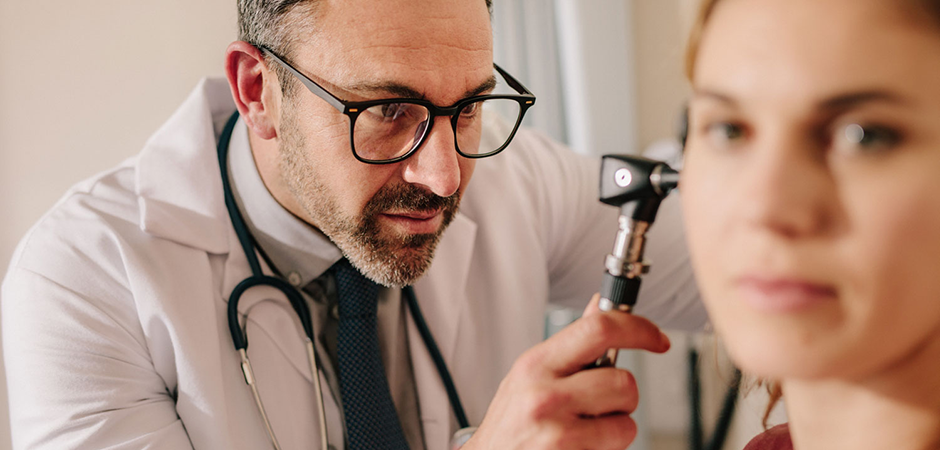
UT Health's board-certified ENT specialists provide complete ear services for all ages. From diagnosis, to medical and surgical treatments, our mission is to provide the highest quality care for all your ear needs.
To learn more about commonly treated conditions and procedures, click the boxes below.
An ear infection (sometimes called acute otitis media) is an infection of the middle ear, the air-filled space behind the eardrum that contains the tiny vibrating bones of the ear. Children are more likely than adults to get ear infections.
Because ear infections often clear up on their own, treatment may begin with managing pain and monitoring the problem. Sometimes, antibiotics are used to clear the infection. Some people are prone to having multiple ear infections. This can cause hearing problems and other serious complications.
Many ear infections resolve on their own, especially if they are viral, and some bacterial infections require treatment with antibiotics. Sometimes recurrent ear infections and/or persistent fluid in the middle ear may become a chronic problem leading to other issues such as hearing loss, poor school performance, or behavior and speech problems. In these cases, insertion of ear tubes by an ENT (ear, nose, and throat) specialist, or otolaryngologist, may be considered.
Ear tubes are tiny cylinders placed through the ear drum (called tympanic membrane) to allow air into the middle ear. They may also be called tympanostomy tubes, myringotomy tubes, ventilation tubes, or PE (pressure equalization) tubes.
These tubes can be made of various materials, and come in two basic types: short-term and long-term. Short-term tubes are smaller and typically stay in place for six months to two years before falling out on their own. Long-term tubes are larger and have flanges that secure them in place for a longer period of time. Long-term tubes may fall out on their own, but removal by an otolaryngologist may be necessary.
Ear plastic surgery can help patients born with underdeveloped, protruding, or drooping ear(s) due to weak or poorly formed cartilage. A partially formed exterior ear is called “microtia,” while a completely undeveloped ear is referred to as “anotia.” Traumatic malformations of the ear also occur due to torn earlobes, automobile or other accidents, animal attacks, and more. Deformity of the ears may cause social anxiety and make children vulnerable to teasing. Regardless of the origin of the ear distortion, many ear conditions can be surgically corrected. These procedures do not alter the patient’s hearing, and may improve appearance and self-confidence.
Abnormally protruding ears can make a person of any age the object of cruel remarks by his or her peers. For any person whose appearance causes concern otoplasty, "ear pinning" should be considered before peer pressure begins to play a significant role in their self-esteem, typically age five or six. When otoplasty is performed at about age 5-7, the development of the ear cartilage is at an optimal state of maturity to accept the modified projection.
Otoplasty is a safe, effective procedure performed to achieve a less noticeable appearance while maintaining function. Because of its potential to foster a person's self-esteem, otoplasty is a most satisfying facial plastic surgery.
Hearing loss that occurs gradually as you age (presbycusis) is common. About one-third of people in the United States between the ages of 65 and 75 have some degree of hearing loss. For those older than 75, that number is approximately 1 in 2.
Hearing loss is defined as one of three types:
- Conductive (involves outer or middle ear)
- Sensorineural (involves inner ear)
- Mixed (combination of the two)
- Aging and chronic exposure to loud noises both contribute to hearing loss. Other factors, such as excessive earwax, can temporarily reduce how well your ears conduct sounds.
You can't reverse most types of hearing loss. However, you and your doctor or a hearing specialist can take steps to improve what you hear.
Tinnitus is the perception of noise or ringing in the ears. A common problem, tinnitus affects about 15 to 20 percent of people. Tinnitus isn't a condition itself — it's a symptom of an underlying condition, such as age-related hearing loss, ear injury or a circulatory system disorder.
Although bothersome, tinnitus usually isn't a sign of something serious. Although it can worsen with age, for many people, tinnitus can improve with treatment. Treating an identified underlying cause sometimes helps. Other treatments reduce or mask the noise, making tinnitus less noticeable.
Benign paroxysmal positional vertigo (BPPV) is one of the most common causes of vertigo — the sudden sensation that you're spinning or that the inside of your head is spinning.
Benign paroxysmal positional vertigo causes brief episodes of mild to intense dizziness. Benign paroxysmal positional vertigo is usually triggered by specific changes in the position of your head. This might occur when you tip your head up or down, when you lie down, or when you turn over or sit up in bed.
Although benign paroxysmal positional vertigo can be a bothersome problem, it's rarely serious except when it increases the chance of falls. You can receive effective treatment for benign paroxysmal positional vertigo during a doctor's office visit.
To learn more about ear, nose and throat services or to schedule an appointment, call 903-676-3316.


